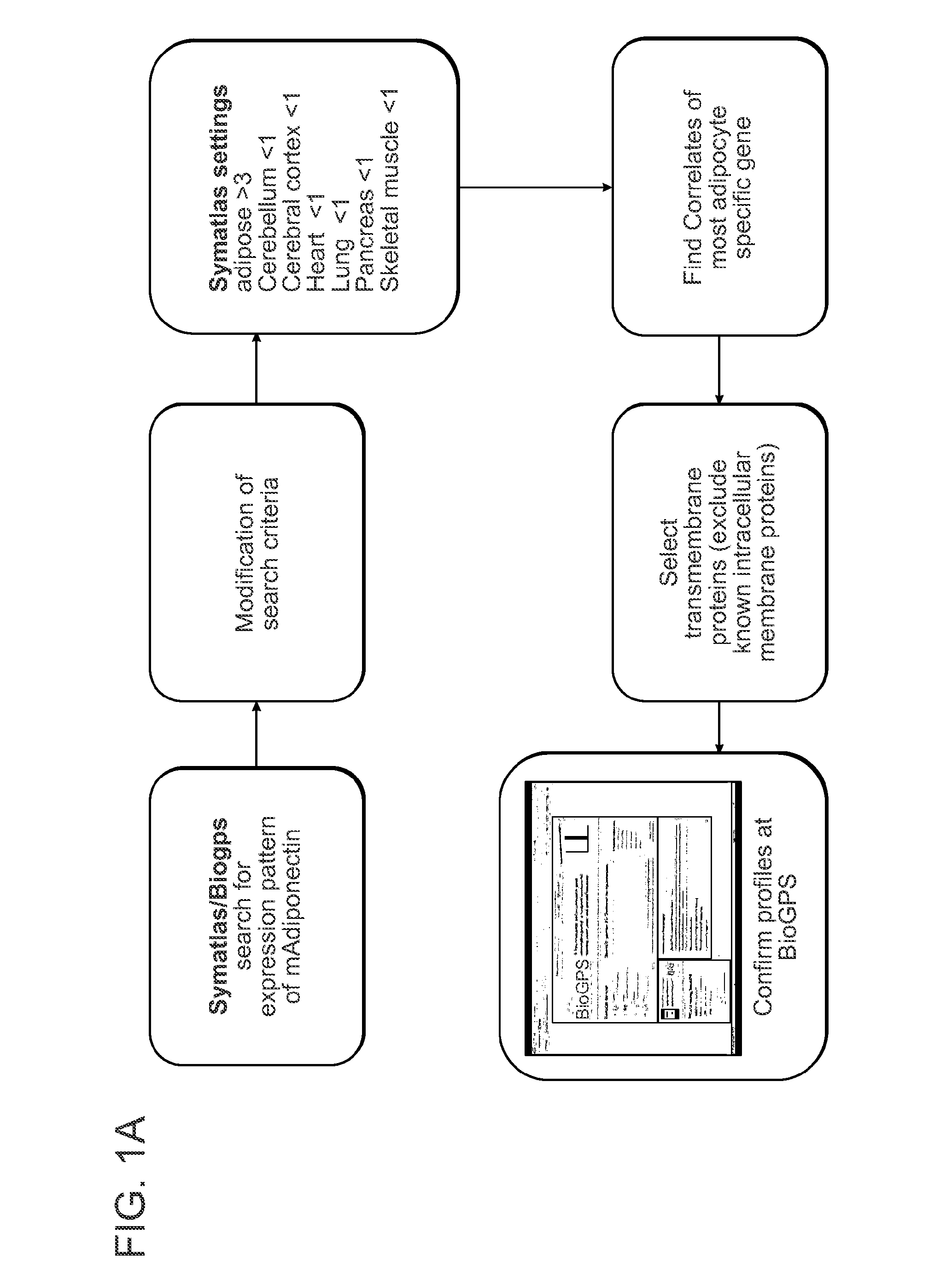Novel surface markers for adipose tissue
a technology of adipose tissue and surface markers, which is applied in the direction of peptides, biological material analysis, dna/rna fragmentation, etc., can solve the problems of lack of translation into effective treatments for these disorders, the exact control of brown versus white preadipocyte commitment is still not known, and the histological differences are limited
- Summary
- Abstract
- Description
- Claims
- Application Information
AI Technical Summary
Benefits of technology
Problems solved by technology
Method used
Image
Examples
example 1
Identification of Adipocyte Specific Cell Surface Markers
[0107]The general approach used herein to identify white and brown adipocyte specific cell surface markers is based on a combination of in silico, in vitro and in vivo techniques. Initially, the Symatlas of gene expression was used and its successor the BioGPS (www.biogps.gnf.org) databases. These databases provide Affymetrix data from more than 100 different tissues and cell lines. In addition to normal searches these databases provide the possibility to search for genes with correlated gene expression profiles in comparison to a selected reference gene, such as UCP1 for brown fat and adiponectin for white fat.
[0108]White Adipocyte Tissue
[0109]Initially genes were searched with a correlation coefficient greater 0.95 compared to adiponectin (as illustrated schematically in FIG. 1a). As illustrated in FIG. 1b, adiponectin expression was not restricted to adipose tissue; significant expression was also found in other tissues. Th...
example 2
Slc7a10 / Asc-1 Regulation During Weight Gain and Obesity
[0113]To gain insights into the regulation of Slc7a10 / Asc-1 during weight gain and obesity Slc7a10 / Asc-1 expression was compared in flank, perigonadal and perirenal fat as well as kidney and liver of ob / ob and control mice (FIG. 4). Significantly increased expression of Slc7a10 / Asc-1 in flank fat and a significantly reduced expression in perirenal fat was observed whereas expression remained unchanged in perigonadal fat as well as kidney and liver. Importantly, however, for the use of Slc7a10 / Asc-1 as a surface maker for white adipocytes, the overall high expression of Slc7a10 / Asc-1 in adipocytes in comparison to other tissues remained unaltered.
example 3
Slc7a10 / Asc-1 Expression was then Investigated During Adipocyte Differentiation
[0114]Slc7a10 / Asc-1 expression was then investigated during adipocyte differentiation. Using 3T3-L1 cells. No significant changes in expression were detected during an eight day time course of differentiation, in sharp contrast to aP2 which increases progressively during adipocyte differentiation (FIG. 5a). Importantly, however, primary preadipocytes freshly isolated from perigonadal and flank fat showed a clear induction of Slc7a10 / Asc-1 expression upon differentiation (FIG. 5b). Cells that failed to differentiate upon induction with the “differentiation cocktail” (as disclosed by Gesta, et al., Proc Natl Acad Sci 103: 6676-6681 (2006)) did not show an increased Slc7a10 expression. This indicates that the increased expression was intrinsic to adipocytes and not a direct consequence of the differentiation cocktail used. These data further support our previous results that Slc7a10 / Asc-1 is a marker for mat...
PUM
| Property | Measurement | Unit |
|---|---|---|
| Mass | aaaaa | aaaaa |
| Surface | aaaaa | aaaaa |
Abstract
Description
Claims
Application Information
 Login to View More
Login to View More - R&D
- Intellectual Property
- Life Sciences
- Materials
- Tech Scout
- Unparalleled Data Quality
- Higher Quality Content
- 60% Fewer Hallucinations
Browse by: Latest US Patents, China's latest patents, Technical Efficacy Thesaurus, Application Domain, Technology Topic, Popular Technical Reports.
© 2025 PatSnap. All rights reserved.Legal|Privacy policy|Modern Slavery Act Transparency Statement|Sitemap|About US| Contact US: help@patsnap.com



